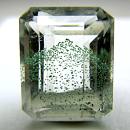|
ClassicGems.net |
|
|
 |
|
Celadonite (inclusions in Quartz) |
|
|
Discovered in 1847; IMA status: Valid (pre-IMA; Grandfathered) |
|||
|
|
|
Chemistry |
|
|
|
|
|
K(Mg,Fe2+)(Fe3+,Al)Si4O10(OH)2 |
|
|
|
Potassium Magnesium Iron Aluminum Silicate Hydroxide |
|
Molecular Weight: |
429.02 gm |
|
Composition: |
Potassium |
9.11 % |
K |
10.98 % |
K2O |
|
|
Magnesium |
4.53 % |
Mg |
7.52 % |
MgO |
|
|
Aluminum |
0.63 % |
Al |
1.19 % |
Al2O3 |
|
|
Iron |
14.32 % |
Fe |
3.35 % |
FeO / 16.75% Fe2O3 |
|
|
Silicon |
26.19 % |
Si |
56.02 % |
SiO2 |
|
|
Hydrogen |
0.47 % |
H |
4.20 % |
H2O |
|
|
Oxygen |
44.75 % |
O |
|
|
|
|
|
100.00 % |
|
100.00 % |
= TOTAL OXIDE |
|
|
|
||||
|
Classification |
|
|
|
|
|
Silicates (Germanates) |
|
|
8/H.10-30 |
|
|
|
9 : SILICATES (Germanates)
|
|
Related to: |
Mica Group. Muscovite Subgroup. Muscovite-Celadonite Series. Polytypes: 1M. The Mg analogue of Ferroceladonite. Isostructural with: Aluminoceladonite, Chromceladonite, Ferroaluminoceladonite, Ferroceladonite, Glauconite. |
|
Members of Group: |
Mica Group: Aluminoceladonite, Anandite, Annite, Annite-Phlogopite Series, Aspidolite, Balestraite, Biotite, Bityite, Boromuscovite, Brammallite, Celadonite, Chernykhite, Chromceladonite, Chromphyllite, Clintonite, Eastonite, Ephesite, Ferroaluminoceladonite, Ferroceladonite, Ferrokinoshitalite, Fluorannite, Fluorphlogopite, Ganterite, Glauconite, Hendricksite, Illite, Kinoshitalite, Lepidolite, Luanshiweiite, Margarite, Masutomilite, Montdorite, Muscovite, Muscovite-Celadonite Series, Nanpingite, Natro-glauconite, Norrishite, Oxykinoshitalite, Oxyphlogopite, Paragonite, Phengite, Phlogopite, Polylithionite, Preiswerkite, Roscoelite, Shirokshinite, Shirozulite, Siderophyllite, Sokolovaite, Suhailite, Tainiolite, Tetraferriannite, Tetraferriphlogopite, Tobelite, Trilithionite, Voloshinite, Wonesite, Yangzhumingite, Zinnwaldite |
|
Varieties: |
None |
|
Synonyms: |
Baldogée, Celedonite, Seladonite, Verona Earth, Veronite |
|
|
|
|
Crystal Data |
|
|
|
|
|
Minute micaceous scales or earthy aggregates. |
|
|
None |
|
|
|
|
|
Physical Properties |
|
|
|
|
|
Perfect on {001} |
|
|
Clay-like fractures with no visible crystalline affinities |
|
|
Fragile; Friable to Unctuous |
|
|
~2.0 |
|
|
2.95 - 3.05 (g/cm3) |
|
|
None |
|
|
Barely Detectable; GRapi = 130.24 (Gamma Ray American Petroleum Institute Units) |
|
|
|
|
|
Optical Properties |
|
|
|
|
|
Blue-Green, Olive-Green, Apple-Green |
|
|
Translucent to Opaque |
|
|
Waxy, Dull, Earthy |
|
|
1.606 - 1.662 Biaxial ( - ) |
|
|
0.0270 |
|
|
Moderate; r < v |
|
|
Visible; x=yellowish-green, y=green or emerald green, z=green or emerald green |
|
|
|
|
|
Occurances |
|
|
|
|
|
Geological Setting: |
Replaces primary ferromagnesian silicate minerals in altered intermediate to mafic volcanic rocks, developed under low-grade zeolite facies metamorphism; as amygdule fillings in basalts or andesites. |
|
Common Associations: |
Montmorillonite, Clinoptilolite, Heulandite, Laumontite, Prehnite, Chlorite, Quartz, Calcite |
|
Common Impurities: |
Mn, Ca, Na |
|
Co-Type Localities: |
•
Planitz, Zwickau, Saxony, Germany |
|
Year Discovered: |
1847 |
|
View mineral photos: |
|
|
|
|
|
More Information |
|
|
|
|
|
|
|
|
|
|
|
Celadonite was named in 1847 by German mineralogist Ernst Friedrich Glocker (1793-1858) from the French word celadon, for sea green, referring to its typical color. The mineral Glockerite was named in his honor in 1855. Glocker is credited with naming over 70 minerals including Arsenopyrite, Halite, Linarite and Sphalerite. Celadonite is a hydrous silicate of iron and potassium that is a member of the Mica Group of minerals that also includes Lepidolite, Muscovite, Phlogopite and Polylithionite. Celadonite is usually a massive, fairly unattractive, mineral except when it is included in other minerals. One example is Indian Zeolites, such as Heulandite, colored green by Celadonite inclusions. Possibly the most beautiful example is Celadonite included Quartz from Madagascar (as seen in the picture at the top of this page). Quartz gems cut to show Celadonite phantom inclusions are particularily beautiful. Massive Celadonite is available from many localities worldwide but gemmy examples of Celadonite included Quartz are only known from Madagascar. |
|
|
Celadonite gems for sale: We have not photographed our Celadonite gems yet. Please check back soon. |